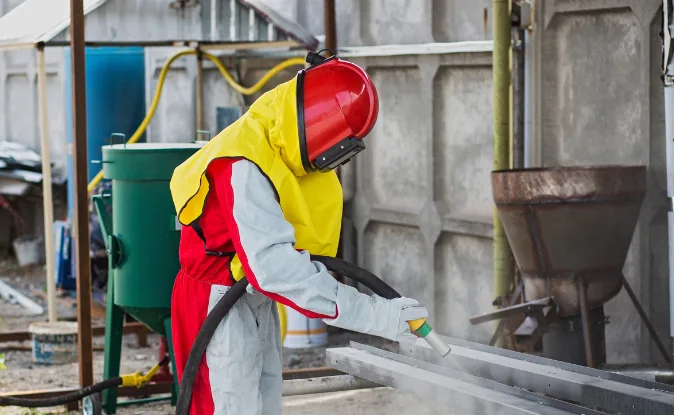Abstract: The application of sand-grain powder coatings on fire doors often encounters performance issues during bending processes, such as cracking and peeling of the coating. This study focuses on the optimization of polyester resin curing conditions, total resin content, coating thickness, additive ratios, and powder particle size to develop a sand-grain powder coating that resists bending for use on fire doors.

Keywords: Powder Coating, Sand-Grain Finish, Bending Resistance
Fire doors serve not only as critical safety features but are also enhanced aesthetically and protected through coatings. Powder coatings are increasingly preferred by manufacturers for fire door applications due to their high production efficiency, simple process, environmental friendliness, high raw material utilization, and ease of automation compared to traditional solvent-based coatings. The conventional coating process for fire doors involves several steps before the final coating application to prevent damage during processing, thus requiring lower flexibility of the powder coatings. However, the incorporation of materials like honeycomb paper, rock wool, glass wool, and aluminum silicate in the fire door assembly increases the weight and complexity of handling, absorbing significant heat and extending heating times, thus reducing production efficiency. A new coating process proposes the application of powder coating before the assembly and bending processes, necessitating powder coatings with high toughness and bending resistance.
The variety of powder coatings used on fire doors includes flat, wrinkle, sand-grain, and transfer powders. Sand-grain powder coatings, in particular, offer aesthetic and decorative benefits, concealing imperfections on the workpiece surface, making them widely used in fire door applications. However, the texture of sand-grain coatings can lead to concentrated stress points during bending, resulting in cracks and peeling.
Ideal curing conditions for powder coatings are achieved when the workpiece reaches a temperature of 190-200°C and is maintained for 10-15 minutes. Given the large size of fire doors and the continuous production process, actual curing conditions are often limited, with measurements from various manufacturers showing curing at 185°C for 10 minutes, and even lower in winter conditions. This study aims to develop a sand-grain powder coating with high flexibility that does not crack during bending (180° folding) and is suitable for harsh curing conditions, meeting the needs of most users with a curing condition of 180°C for 8 minutes. Using polyester resin as the base material, the study adjusts formulations and controls production processes to obtain a stable quality, bending-resistant sand-grain powder coating.
The materials used include industrial-grade polyester resins (SJ4″E, SJ4700, SJ4800), curing agent (TGIC), leveling agent (KC758), barium sulfate (precipitated), talcum powder (800 mesh), sand-grain agent (816), organic bentonite, and flexibilizer (F-105). The experimental setup includes various industrial-grade instruments and equipment for preparation and testing of the powder coatings.
This research addresses two main challenges: achieving high flexibility in sand-grain powder coatings to prevent cracking during bending and adapting to stringent curing conditions. By selecting appropriate polyester resins and adjusting the formulation and production process, this study aims to produce a stable quality, anti-bending sand-grain powder coating for fire doors, contributing to the advancement of coating technologies in the China fire door factory sector and enhancing the performance of multi-door access systems for steel fireproof doors.
In conclusion, the study has successfully addressed the challenges associated with bending resistance in sand-grain powder coatings for fire doors by optimizing the formulation and processing conditions. Key findings include:
- The reaction speed of polyester resins significantly affects the bending resistance of sand-grain powder coatings. A combination of polyester resins SJ4’E and SJ4700 in a 1:1 ratio was found to be optimal.
- Resin content and coating thickness play a crucial role in the performance of the anti-bending sand-grain powder coatings. It was determined that a resin content of 60% and a coating thickness of 50-70 μm are ideal.
- The addition of a flexibility agent at 0.5% was found to improve the impact resistance and bending performance of the coatings without significant changes at higher concentrations.
- Particle size has a notable impact on the OT bending performance of the coatings. A median particle size of 35μm resulted in a fine texture of the coating with good storage stability.
- Through the selection of polyester resins, adjustment of resin content, comparison of coating thickness, adjustment of additive amounts, and control of particle size, an optimized formulation was achieved. This formulation enhances the spreading and wetting effects of basic zinc phosphate and its derivatives when modified with a coating, improving its thermal stability and performance in various paint systems.
This study contributes to the development of high-quality, bending-resistant sand-grain powder coatings for fire doors, supporting the manufacturing capabilities of China fire door factories. It also lays a foundation for further research into multi-door access systems for steel fireproof doors, emphasizing the importance of preparation of anti-bending sand-grain powder coatings in enhancing the functionality and durability of fire doors.
